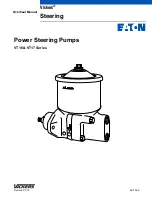
English (GB)
13
3.3 Frequency converter operation
For frequency converter operation, please observe the following
information:
• Requirements must be fulfilled.
• Recommendations ought to be fulfilled.
• Consequences should be considered.
3.3.1 Requirements
• The thermal protection of the motor must be connected.
• The peak voltage and dU/dt must be in accordance with the
table below. The values stated are maximum values supplied
to the motor terminals. The cable influence has not been taken
into account. See the frequency converter data sheet
regarding the actual values and the cable influence on the
peak voltage and dU/dt.
• If the pump is an Ex-approved pump, check if the Ex certificate
of the specific pump allows the use of a frequency converter.
• Set the frequency converter U/f ratio according to the motor
data.
• Local regulations and standards must be fulfilled.
3.3.2 Recommendations
Before installing a frequency converter, calculate the lowest
allowable frequency in the installation in order to avoid zero flow.
• Do not reduce the motor speed to less than 60 % of rated
speed or 30 Hz.
• Keep the flow velocity above 1 m per second.
• Let the pump run at rated speed at least once a day in order to
prevent sedimentation in the pipes.
• Do not exceed the frequency indicated on the nameplate. If
you do, there is risk of motor overload.
• Keep the motor cables as short as possible. The peak voltage
will increase with the length of the motor cables. See the data
sheet for the frequency converter used.
• Use input and output filters on the frequency converter. See
the data sheet for the frequency converter used.
• Use screened motor cables if there is a risk that electrical
noise can disturb other electrical equipment. See the data
sheet for the frequency converter used.
3.3.3 Consequences
When operating the pump via a frequency converter, please be
aware of these possible consequences:
• The locked-rotor torque will be lower. How much lower will
depend on the frequency converter type. See the installation
and operating instructions for the frequency converter used for
information on the locked-rotor torque available.
• The working condition of the bearings and the shaft seal may
be affected. The possible effect will depend on the application.
The actual effect cannot be predicted.
• The acoustic noise level may increase. See the installation
and operating instructions for the frequency converter used for
advice as to how to reduce the acoustic noise.
4. Starting up the product
You can start the pump using either direct-on-line (DOL) starting
or star-delta (Y/D) starting. The selection of starting method
depends on several considerations on usage and mains supply
conditions.
We recommend that you use a time relay with a switching time of
maximum 50 ms or according to the starter manufacturer's
specifications.
The wiring diagrams for direct-on-line starting and star-delta
starting are shown in fig.
. See also the wiring
.
Fig. 15
Direct-on-line starting
Fig. 16
Star-delta starting
When the motor is driven via a
frequency converter, the
temperature class of explosion-
proof pumps must be T3.
Maximum repetitive
peak voltage
[V]
Maximum dU/dt U
N
400 V
[V/
μ
sec.]
850
2000
If you use star-delta starting,
keep the switching transient time
to a minimum to avoid high
transient torques.
T
M
05
16
38
33
11
TM
05
16
39
33
11
V1 W1
U1
PE
V2
U2
W2
PE
L1
M
L3
L2
3
Control
Cable
V1 W1
U1
PE
V2
U2
W2
PE
L1
M
L3
L2
3
Control
Cable














































